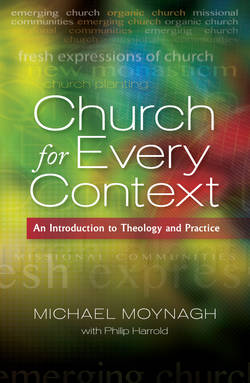Читать книгу Church for Every Context - Michael Moynagh - Страница 40
На сайте Литреса книга снята с продажи.
Paul’s churches
ОглавлениеCertainly the churches that he founded continued the Jerusalem and Antioch practice of both meeting separately in homes and meeting together. ‘The household was much broader than the family in modern Western societies, including not only immediate relatives but also slaves, freemen, hired workers, and sometimes tenants and partners in trade or craft’ (Meeks, 2003, pp. 75–6). Patronage networks were important, too. New house churches, therefore, were ‘inserted into or superimposed upon an existing network of relationships’ (p. 76). In other words, they were largely comprised of homogeneous people groups, formed around hierarchical ties.
It is clear from 1 Corinthians 14.23, where Paul writes of the ‘whole church’ coming together, that these separate house gatherings periodically met as a single group, probably in a large home such as the one apparently owned by Gaius. In the concluding section of Romans, most probably written in Corinth, Paul sends greeting from Gaius, whose hospitality ‘the whole church here’ enjoyed (Romans 16.23). ‘In the Greek Old Testament this expression consistently refers to an assembly of all Israel; thus it must be the totality of Christians in Corinth which is in view’ (Banks, 1980, p. 38).
The meeting of the Ephesian elders in Acts 20 is suggestive. Luke says that ‘Paul sent to Ephesus for the elders of the church’ (v. 17). The reference is to the church as a single unit, a thought echoed in verse 28, where Paul urged the elders to keep watch over ‘the flock’, again singular. Evidently the house churches in Ephesus, which presumably emerged from the homes Paul visited in verse 20, had a sense of themselves as a citywide entity, a self-perception that would be natural if they periodically met together. The elders summoned by Paul may well have been the leaders of house churches who were used to assembling together (perhaps to plan the wider meetings).
Gehring maintains that recent scholars tend to agree that the early Christians gathered in two church forms: the house church and the whole church at any given location. While these two forms of church were geographically fixed, he suggests that the experience of individual gatherings could have been quite fluid. Congregations may often have lived in an in-between sphere hard to define (Gehring, 2004, p. 173).
New Testament believers appears to have found a way of combining homogeneous people groups with the potential to bridge social divides. This both/and approach held together sameness and diversity, small meetings and larger ones, and intimacy plus exposure to different ideas. Achieving this was far from easy, as the divisions at Corinth demonstrated, but Paul saw it as a priority.
For reflection
Some might say that Paul’s house churches were not strictly homogeneous groups. They contained for example slaves and heads of households, who were to relate to each other not in hierarchical ways but as ‘brothers and sisters’. Each house church modelled diversity. The only thing that members had in common was that they lived in the same area. Others might question the assumption that members drawn from the same area are not a homogeneous group. Don’t geographical divides often reflect social ones?
Is this a question about what counts as a homogeneous group? Or is it about whether, theologically, some forms of homogeneity are to be preferred than others?
